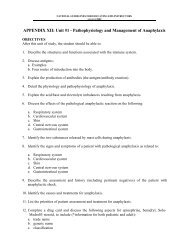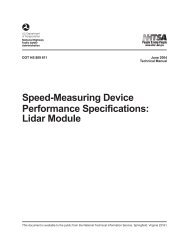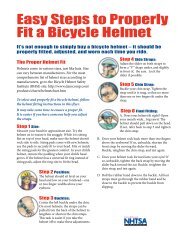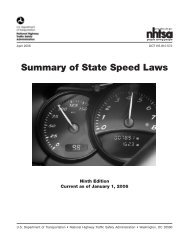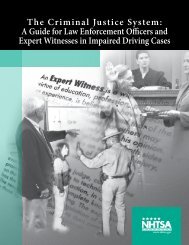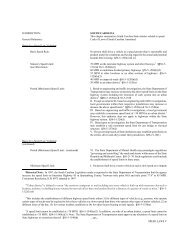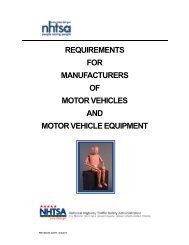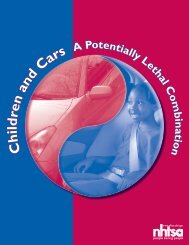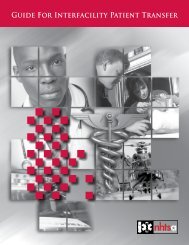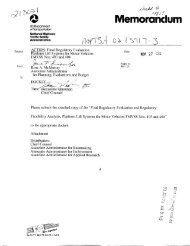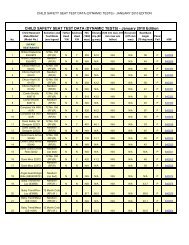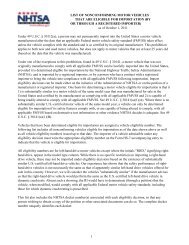Standard Practice for Emergency Medical Dispatch ... - NHTSA
Standard Practice for Emergency Medical Dispatch ... - NHTSA
Standard Practice for Emergency Medical Dispatch ... - NHTSA
Create successful ePaper yourself
Turn your PDF publications into a flip-book with our unique Google optimized e-Paper software.
status of consciousness and breathing, and the dispatch response code, facilitating<br />
preparation <strong>for</strong> possible use of an automated external defibrillator. Prearrival<br />
instructions in the case of a cardiac arrest would entail dispatcher-assisted CPR.<br />
For a patient with chest pain, additional dispatcher interactions with the caller are<br />
recommended to overcome caller or patient denial or to validate that the caller's<br />
descriptions of symptoms and signs may represent the presentation of a heart<br />
attack. Specifically, the dispatcher may ask the caller if the patient has severe<br />
indigestion; tightness; heavy pressure; constricting band and crushing discom<strong>for</strong>t in<br />
the chest with the spread of these feelings to the arms, jaw, neck, or back; as well<br />
as the presence of nausea or sweating. Verification of these symptoms directs the<br />
dispatcher to advise the responders so that their functions at the scene can be<br />
expedited.<br />
Prearrival instructions in these cases would include correct positioning of the patient,<br />
instructions <strong>for</strong> vomiting, and instructions to monitor very closely and call back if the<br />
patient's condition worsens.<br />
Telephone aid. Telephone aid, as defined herein, consists of "ad libbed" instructions<br />
provided by either trained or untrained EMD's. Telephone aid differs from dispatch<br />
life support in that the instructions provided to the caller are based on the<br />
dispatcher's previous training in a procedure or treatment but are provided without<br />
following a scripted prearrival instruction protocol. This method exists because either<br />
no protocols are used in the medical dispatch center or protocol adherence is not<br />
required by policy and procedure (e.g., the dispatcher is "trained" in CPR and thus<br />
describes to the caller, to the best of his or her verbal ability, how to do CPR).<br />
As noted in the section (above) on prearrival instructions, dispatchers must carefully<br />
adhere to written protocols.<br />
Un<strong>for</strong>tunately, coupled with a growing interest and ef<strong>for</strong>t within public safety<br />
agencies to provide some type of telephone instructions to callers, many agencies<br />
are "allowing" dispatchers to ad lib instructions. There appears to be a significant<br />
difference between dispatch life support-based prearrival instructions and telephone<br />
aid. Telephone aid, as defined, may only ensure that the dispatcher has attempted to<br />
provide some sort of care to the patient through the caller but does not ensure that<br />
such care is correct, standard, and medically effective or even necessary in the first<br />
place.<br />
Telephone aid often causes the following predictable errors:<br />
1. Failure to correctly identify conditions requiring telephone intervention and<br />
there<strong>for</strong>e prearrival instructions in the first place (e.g., "saving" an infant having a<br />
febrile seizure who was incorrectly identified as needing CPR due to failure to follow<br />
protocols that are medically designed to verify need -- verify breathing, pulse, etc.,<br />
be<strong>for</strong>e potentially dangerous dispatcher-invasive treatments such as compressions<br />
are initiated).<br />
2. Failure to accurately identify the presence of interim symptoms and signs (or the<br />
lack of them) during the in-progress provision of telephone intervention (e.g.,<br />
dispatchers who ad lib CPR sequences often miss important patient verifiers that<br />
cannot be seen by the dispatcher, such as watching <strong>for</strong> the chest to rise).<br />
81



